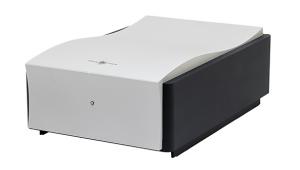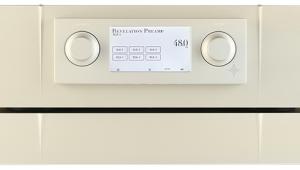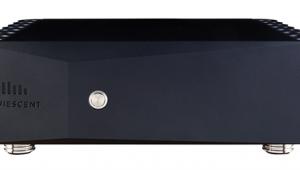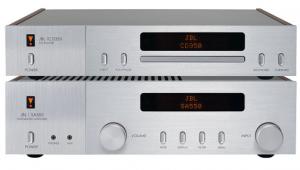Conrad Johnson Et3se (£4920)
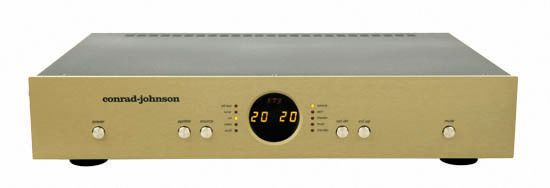
Now that tube amplifiers seem to grow on trees, at least in China, it’s hard to imagine the overwhelmingly solid-state hi-fi scene of 35 years ago. In America, though, a tube revival was coming. Audio Research had been selling new hi-fi tube amplifiers since 1970, while many audiophiles were still finding something in the sound of old tube amps that seemed to be missing from the shiny new solid-state stuff.
Among those users of classic tube equipment were Dr William Conrad and Dr Lewis Johnson, two economists who were both also keen audiophiles. Dissatisfied with the sound of new equipment, they were also perplexed by the sonic differences among the components in their own two systems. In a quest to combine the virtues of both, they decided to investigate systematically and to develop a tube preamplifier themselves. Later named the PV1, this became the first Conrad-johnson product in 1977. A power amp followed a year later.
Conrad and Johnson have largely gone on refining, and using better passive components to get improved subjective results from the same basic circuits. In parallel with the PV range was the more expensive Premier series, with pre- and power amps. Developments from Premier models – for example microprocessor-controlled stepped attenuator volume controls – were trickled down into the PV models. Now, though, the old PV and Premier range structure has been replaced by a new and simpler programme, and it’s noticeable that the old lowest-cost models have not been replaced.
UPGRADED COMPONENTS
This ‘special edition’ preamp, the ET3SE (£3495 if line-level only), comes with a big helping of Conrad-johnson’s specialist parts, as does the matching ETPHSE phono stage option. As you’d expect, Conrad -johnson’s favoured Teflon capacitors replace polypropylene types in crucial locations. In the line stage, these include the output coupling bypass, the main storage bypass capacitor and the voltage reference filter capacitor. Many resistors are upgraded to Vishay types and these include the 100ohm input and output damping resistors, and all 26 volume control resistors. Grid load resistors in the line stage are upgraded to Cadduck. Similarly, in the ET3SE phono stage the interstage coupling capacitor, power supply storage capacitor and current source filter are upgraded to Teflon. Again, in the phono stage, the input and output damping resistors are upgraded to Vishay parts. Input and output RCA (phono) connectors are upgraded to a discrete hand-wired type.
Rotary volume controls disappeared from Conrad-johnson’s vision years ago, and so the ET3SE fascia carries the now-familiar combination of up-and-down pushbuttons and circular display window. This gives a numeric display of volume settings from 0 to 99, these representing the attenuator’s 0.7dB steps. This resolution is fine enough for any but the most neurotic level-tweaker.
This model has no balance control to adjust the relative level of L/R channels, so although the two figures displayed seem to represent the two channels, they can in fact only change in unison.
LED MATTERS
Other front panel controls start with a ‘power’ button at the far left. There is no other main power switch, so pressing this button brings the ET3SE up out of standby mode, in which all the tube circuitry is switched off. It remains muted on switch-on for a minute or so while the tubes warm up, and will then become active, with the same volume setting as before, with the source defaulting to CD. However, if it has been disconnected from the mains (or switched off at the wall socket) it will emerge from standby with a default volume setting of 20.
Next come two buttons for source selection, one of them cycling to select the external processor loop (or ‘tape monitor loop’) and home theatre bypass mode when needed, the other cycling through the five main line inputs, with LEDs to show the selection. The top LED is labelled ‘ph/aux’, as the aux sockets become the phono input when a phono stage is fitted.
To the right of that display window, along with the volume buttons, are more LEDs. The top three indicate whether you’re listening to a direct source or via the EPL or Theatre loops, while the next one lights if you use the far right Mute button, and flashes during warm-up. The final LED is the only light to stay on in standby mode.
All the front panel controls are duplicated on the remote handset supplied, and I guess that in practice you will use this most of the time. Pressing and holding the remote’s Mute button puts the unit into standby, but its balance control buttons are inoperative with this model. After all this you’ll hardly need telling that there are five pairs of line-input phonos, plus input and outputs for EPL and Theatre modes, and finally the main outputs.
Our phono stage was the high-gain version, catering for cartridges with an output of up to 1mV and suitable for most MCs. A lower gain version is also available. Two sets of DIP switches on the circuit board can be used to change the input load impedance from the default setting of 47kohm to 9.6k, 1.9k, 500 or 200ohm.
IMPRESSIVE SWEEP
My listening started with vinyl, using the Benz Micro Glider SL in the SME 10 turntable. Though it’s mono, the 1955 jazz classic Dinah Jams [Japanese EmArcy EXPR-1013] seemed as good a way to warm up a system as any. Recorded with an invited audience, this was an attempt to capture the excitement of a live session with studio sound quality. With the ET3SE, the sound was smooth yet flowing and detailed, and it really drew me in.
Switching from the ET3SE’s own phono stage to the always-pleasing Acoustic Signature Tango gave a relatively flattened and laid-back perspective, or rather less mono stage depth. I felt that the ET3SE’s phono stage gave more detail, more feeling of a real event, even though of course you were still listening down a mono ‘tube’ rather than to a real stereo spread. Many valve products give a mono image rendition that is worryingly vague, but this was not the case with the ET3SE preamp.
With the Grateful Dead’s Dead Set of 1980 [Arista DARTY 11], the big stadium sound came over well enough, again with an effect that was laid back and slightly vague in spatial terms. Phil Lesh’s incredible, intelligent bass lines were clean and deep against the complex drum sounds of Hart and Kreutzmann. Possibly, though, a truly rock-oriented listener might want a more incisive quality here, with more obvious slam and snap.
With Christine Collister’s 2005 ‘Rega project’ album Love [Rega ENS 002] the ET3SE really projected the darkly-rich almost cloudy texture of this singer’s distinctive voice, and it was nicely revealing of the different production sound achieved on different tracks. It made you appreciate the versatile musicianship of Gary Bennett, from his wistful-clunky banjo on ‘Time In A Bottle’ to his lovely yearning electric guitar line on ‘I’ve Got You Under My Skin.’
Turning to classical vinyl, the ET3SE was excellent on the 1979 EMI recording of Beethoven’s Seventh Symphony with Riccardo Muti and the Philadelphia Orchestra [ASD 3646]. This benefits from the fine engineering of Christopher Bishop and Michael Gray and the great acoustic of the Philadelphia Met Church (incidentally, built as a theatre by Oscar Hammerstein’s grandfather).
This preamp conveyed the depth of staging in the recording, and you could enjoy the impressive sweep of the orchestra in full cry because it gave you the timbral qualities of strings and woodwinds even in the massive climaxes of the first movement, not to mention the magical slow second one. You could feel the acoustic and the way it complemented the music in an unusually happy way.
I couldn’t leave the phono section without putting on ‘Sultans Of Swing’ from Dire Straits [Vertigo 9102 021]. This chameleon-like track seems to change pace and mood with every different system. Here, subjectively, the feeling was of fast, loping country-rock, the bass and drums stunningly integrated, the layered rhythm guitars providing a smoothly-layered backdrop rather than too many jangly edges. Against this, Knopfler’s vocal sounded completely relaxed, if not as characterful as it sometimes can. His lead guitar sounded smooth rather than ringing out, but it came over in its full power and authority.
Moving on to CD, the ET3SE elicited a tremendously big and room-filling sound on Pierre Bensusan’s lovely guitar album Intuité [Favored Nations 2130]. This is a production that’s been given an almost bathroomy acoustic, and the ET3SE seemed to revel in this. Yet at the same time, it was convincing and enticing in its presentation of the plucking detail and string noises that made you feel you really were in the presence of the player, however oversized his instrument had become.
For a big sound but in a more natural acoustic, I moved on to Marta Gomez and the sound of St Peter’s Church on Entre Cada Palabra [Chesky JD301]. On the opening ‘Maria Mulata’, the usually rampant bass seemed almost restrained, and if you closed your eyes you got a good feeling of image depth and width. The track’s panoply of handclaps, claves and other things being hit was presented naturally rather than flashily. But even if the ‘audiophile’ details in this recording weren’t particularly stunning, the presentation of Marta’s vocals was lovely, with real depth and expression, and never a hint of hardness. It was great to hear the smile in her voice on ‘De Amarillo...’ and her seductive lilt in ‘Mar Adentro...,’ a track where the ET3SE’s rhythmic abilities seemed to come through particularly well.
With Famous Blue Raincoat [Classic Records RTHCD 5052] I felt that Jennifer Warnes’ amazing voice was equally well served, with that magical combination of sweetness and commanding presence well conveyed, and again with never a hint of hardness or edge.
The title track now seemed a particularly fabulous vocal performance, while Paul Ostermayer’s definitive sax was free of the stridency that’s often heard on the CD version. Although, as with other examples, the bass never seemed overtly punchy, it supported rhythmically coherent structures without fuss.
CHANGING ROOMS
Finally, following the Lab Report comments on microphony, I also tried listening to the sound of ET3SE on Keith Jarrett’s Jasmine with Charlie Haden [ECM 273 3485] with the preamp removed from the influence of the speakers.
Using unbalanced cables of normal length, I could only do this by moving the whole system except the speakers out of the room. This meant I wasn’t listening only to the effect of changing the ET3SE’s environment. With the equipment out of the room, I felt that there was a more real shape to the image of the piano, and also that with Charlie Haden’s immaculately-struck bass notes there was now a more subtle sense of felt vibration to complete the heard sound. I can’t claim that this crude comparison proved anything about the ET3SE, but it was certainly food for thought.
VERDICT
A real step up from earlier equivalents, the ET3SE gives you a well-judged presentation of the music rather than obviously-impressive ‘hi-fi’ effects. Its miraculously clean, smooth treble could be balm for an overbright system, and it has an unemphatic but informative bass quality. Above all, it has a beautiful sense of ease and flow. An expensive box, with some slight ergonomic quirks, but sonically it delivers.
Originally published in the May 2011 issue






